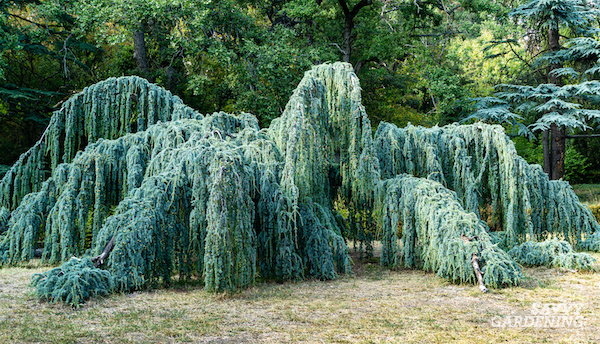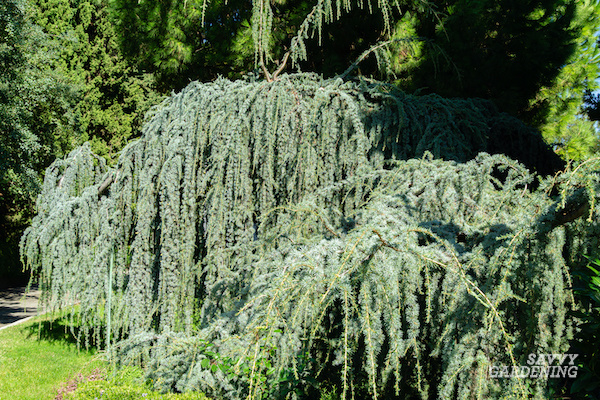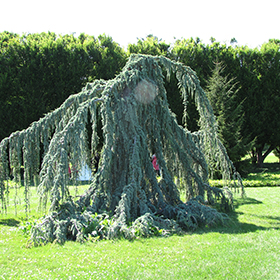Among other Atlas cedars, the Blue Atlas Cedar is one of the most well-liked trees. Cedrus Atlantica has beautiful silver blue foliage, which is characteristic of cedars, and it spreads out numerous branches, making it a totally evergreen blue atlas tree. This tree may fit into any landscape and is quite graceful. Let me share with you a fact: Trees improve the appearance of a garden, a lawn, or a school.
People prefer blue atlas cedars over other well-liked trees because they are simple to maintain and provide a stunning pyramidal design. Early in its life, this tree retains its narrow cone shape, but around the age of 18 to 20 years, it begins to broaden into a pyramidal shape. These trees are attractive in large spaces, but you can also grow them in a sizable backyard.
Let me now provide you with some background information on it.
Background Details
Cedrus Atlantica ‘Glauca’ is the scientific name for the Blue Atlas Cedar, which is a member of the Pinaceae Family, a subfamily of the Pine Family. Originally found in Morocco’s Middle and High Atlases, this tree also has an Algerian provenance, according to one account.
According to some sources, it is a subspecies of Lebanon cedar, while others refer to it as a separate species. The height and width of a blue altas cedar are up to 30-40 feet and 30-40 feet, respectively, respectively, according to the University of Utah and North Carolina Extension Gardening. This plant is hardy in USDA zones 6-9.
You can purchase this live plant by clicking on the links below.
PURCHASE CHECK IN AMAZON
Three Exceptionally Different and Beautiful Cedar Tree Varieties
Check out the price for Horstmann Blue Atlas Cedar on Etsy.
Serpentine: Weeping Blue Atlas Cedar (Check Price on Etsy)
Check the price of a golden deodar cedar tree on Etsy.
Fast facts:
| Scientific Name | Cedrus atlantica |
| Other Names | Weeping blue Atlas cedar |
| Origin | Africa |
| USDA Hardiness Zone | 6–9 |
| Plant Type | Evergreen tree |
| Soil Needs | Well-drained |
| Height | 50–60 feet tall |
| Width | 35–40 feet wide |
| Flower Color | No Color |
| Light Requirement | Full sun |
| Bloom Time | Doesn’t Flower |
| Uses | Landscapes and garden |
| Pruning | Slightly Trim Once In Few Year |
| Pests Infestation | Scale |
| Fertilizer | Liquid based plant food |
Table of Contents
How to Grow Blue Atlas Cedar
Cedrus Atlantica can thrive in a variety of soil types, although a mixture of clay, silt, and sand in a 20-40-40 ratio would be the ideal. As a result, it’s important to find a place where the trees will receive adequate 8–10 hours of sunlight. However, the beauty of the cedar tree is that it can also thrive in shaded areas.
Grow Blue Atlas Cedar: You should safeguard these young trees from strong winds and storms since those conditions give them shelter. Given that Cedrus Atlantica trees take roughly 15 years to reach a height of 30 feet, it is important to maintain your composure and refrain from asking how long it will take for a tree to achieve a particular height. This means that the tree will only grow by an average of 1 and 1/2 feet every year. You must take care of it because the tree is strengthening its trunk (main stem) at this time.
The following are 8 advices for growing Cedrus atlantis:
Light
There is no need to cultivate it in a shaded spot because it needs full light.
To form stems, grow larger & healthier, and create their stems, they require 6–8 hours of sunlight daily.
Soil
Although you can provide them with additional minerals to ensure optimal growth, they can tolerate ground soil.
Sand, clay, and silt are present in a ratio of 40:20:40%, and this tree will be in good shape as a result of the improved water drainage.
Potting Repotting
Although it is not necessary for this plant because it will be growing in a garden, you can cut the additional grass growing next to the tree’s roots.
Temperature
Your Cedrus Atlantica may experience problems if the temperature drops below zero.
The blue atlas cedar needs to be watered, fed plant food (fertilizer), and other cared for. However, if freezing persists below the point for an extended length of time, the plant will eventually lose all of its leaves and die. Therefore, take careful care of it as this tree typically survives.
Fertilizer
The finest fertilizer, which is frequently used, is 10-8-6 fertilizer, which includes 10% nitrogen, 8% phosphorus, 6% potassium, and is sufficient for cedar trees. You can apply fertilizer in the early spring of each year. Fertilizer is used to increase a plant’s overall strength and growth.
Fertilizer
PURCHASE CHECK IN AMAZON
Humidity
When they are young, these plants (Cedrus Atlantica) can withstand levels of mild humidity. It can quickly acclimatize to dampness after maturing.
Pruning
pruning that truly gets rid of the dead stem and leaves to prevent it from growing nasty You can prune in the early spring and remove any brittle branches or fading leaves. Additionally, pruning is done to keep the tree in shape and prevent it from growing bushy and unattractive.
Propagate
The seeds are the greatest approach to cultivate it; stem cutting is not a good alternative. The tree itself will provide you with the seed. The process is intricate, therefore I went into great detail on how to spread it in the essay below.
Blue Atlas Cedar Care
You need high-quality compost to take care of this tree so it has good drainage. Put this in 1-2 inches of soil, close to the roots. Here are some advice for taking better care of Cedrus atlanta:
Water them only.
when the soil’s surface is completely dry. The plant needs moisture when it is young.
To retain moisture.
To prevent the plant’s top layer (Cedrus Atlantica) from drying out too quickly, mulch must be applied.
Use of bark or bulk straws.
Just place it there with a gap of no more than two inches. The mulch on the surface will be adjusted by the soil and water.
Prune it.
to prepare it properly. Neem oil can be sprayed on pests and illnesses to kill them.
Pests and Diseases Problems
According to the Tree Heritage, this tree is susceptible to a fungus known as Sirococcus Blight. Check your Cedrus Atlantica trees for these diseases if you see that the needles are turning pink, then brown, and finally starting to fall. Unfortunately, there is no known cure for this illness. Contact the forest department office to report any tree diseases so they can research treatments. Other than this, the tree is free of pests and illnesses.
Blue Atlas Cedar Propagation
Follow these steps if you already have a tree:
Take out Seeds
Take a healthy cone from the plant’s cones (needle-like leaves). You will need moisture for the seed to germinate, so take a tissue paper, place the seed inside, spray water on the seed, cover it with another tissue paper, and store it in the refrigerator.
Spray after every 2-3 days.
if the water evaporates. After that, plant the seed in a pot with high-quality organic compost and well-drained soil as soon as germination begins.
Only 1 seed for a 4-5 inch pot.
After that, poke two or three holes in the plastic bag you’re using to cover the pot.
Once you see its sprout.
After two to three weeks, expose it to direct sunshine.
At the time of germination.
Maintain it in the sun. This is how you propagate something; when you take care of it, it will grow and continue to exist.
Types of Blue Atlas Cedar
Atlas cedar trees come in a number of types. With additional details on each cedar tree, we have discussed a few of the varieties. The following list of blue atlas cedar varieties:
Weeping Blue Atlas Cedar
The best growth for weeping blue atlas cedar trees occurs in hot and warm climates. Weeping cedar is a beautiful tree with branches that flow down like waterfalls and icy blue leaves. Blue atlas cedar and cedar trees are very comparable and interesting trees that can be introduced to any landscape. This tree is easier to grow and gives your yard a lovely evergreen appearance.
It can grow upright and has silver-blue, needle-like leaves. In severe storms, shake can be employed to support this plant’s trunk. Due to its distinctive and common structure, it can grab everyone’s attention. In USDA hardiness zones 6 to 9, this can grow.
The scientific name of this tree is Cedrus atlantica “glauca pendula,” and it stands out due to the downward-moving branches, which make it a wonderful example and the only tree that may have such a distinctive structure. In order to prevent people from becoming lost, you can utilize this tree to create a source or destination point in your garden or landscape.
Atlas cedar, its parent tree, has a pyramidal shape, incredible huge size, and a lot of blue leaves. They can withstand the cold temperature and are hardy in zones 6 to 9. Weeping blue cedars are unique and unusual trees because of their ability to resist temperatures as low as -10 degrees F. Additionally, it has a sturdy trunk, so there is no need to be concerned before placing the cedar tree in your expansive garden.
Blue Atlas Cedar Serpentine
The structure of blue atlas cedar serpentine, which resembles a snake moving in a zigzag pattern and forming a “S” with its branches, makes it unusual. It is cultivated in walls or in free standing with stake support while this tree is young because of its evergreen leaves, which give it a lovely appearance. If you have room, it can spread out farther and reach heights of more than 14 feet. A wonderful example of a weeping blue atlas cedar.
Horstmann Blue Atlas Cedar
It features tightly packed branches and frosty blue needles (leaves). As a semi-dwarf tree, the Horstmann Blue Atlas Cedar is smaller in height than dwarf trees. Despite its irregular structure and bluish foliage, it nevertheless manages to look attractive. This tree can be grown in modest to tiny spaces. Its bluish hue mixes in well with the cold, snowy conditions.
Dwarf Blue Atlas Cedar
One such species that stands out among other trees and appears evergreen and brilliant with its bluish foliage in the winter is dwarf blue atlas cedar. This dwarf type can grow to be much taller than its other varieties, reaching heights of 450–50 feet and widths of 23–25 feet. Smaller areas can support the growth of plants in the USDA Hardiness Zones 6 to 9. This will grow much bigger and healthier if you plant it somewhere that it can receive direct sunshine.
Columnar Blue Atlas Cedar
A kind of columnar blue atlas cedar has bushy blue-green leaves that turn silvery as they mature and grows vertically. Due to its comparable thin pyramidal structure to the blue atlas cedar and the space between its diagonal curves, it can be cultivated in small gardens and lawns.
Get Now Here are the hyperlinks:
Blue Atlas Cedar – AMAZON PRICE CHECK
Three Exceptionally Different and Beautiful Cedar Tree Varieties
Check out the price for Horstmann Blue Atlas Cedar on Etsy.
Serpentine: Weeping Blue Atlas Cedar (Check Price on Etsy)
Check the price of a golden deodar cedar tree on Etsy.
Blue atlas cedar wiki
Atlas blue cedar According to Wikipedia, the president of the United States’ residence, the white house, and the south lawn also have these beautiful trees.
Blue Atlas Cedar bonsai
If you are interested in atlas cedar, you have certainly seen images on Instagram or Pinterest showing how stunning atlas cedar bonsai are. They are a miniature version, but it is still worth checking, as they appear just like a large cedar will. Here is the link to buy the artificial small blue cedar tree if you’re interested.
Look at these pictures of a blue atlas cedar bonsai now:
Purchase a Cedar Tree Bonsai Artificial. CHECK PRICE ON AMAZON
FAQ’s
What size can a blue atlas cedar reach? According to University of Florida, blue atlas cedar grows to a height of 40 to 60 feet, making it fairly large and spreading out to a length of 25 to 40 feet when fully grown.
What is the price of a blue atlas cedar? You can pay about $160 for this blue atlas cedar, which is 4-5 feet tall and 2-2.5 years old. It will cost you about $30 to take fresh young plants. Everything is size dependent, and both online and offline retailers’ pricing vary. Although you can purchase seeds that are less expensive, it takes time for a seed to grow into a plant, so aim to choose a plant that is at least two years old.
What is the lifespan of blue atlas cedars? The blue atlas cedars have a lifespan of over 80 years and can grow up to 50 feet tall and 40 feet broad. Even if it develops slowly, you can still enjoy watching it because the tree can live a lifespan comparable to that of an adult human, making it lovely to observe as it ages alongside you. Basically, it’s a younger version of your pal.
How is the blue atlas cedar maintained? Blue Atlas Cedar Trees require a lot of water when they are young in order to strengthen their roots, but they should not be overwatered since this can damage their roots. Always make sure the soil is dry; if it is, water; if not, do not. You should examine the soil regularly while it’s hot outside because it needs water then. Mulching can help a plant retain water for a longer period of time. Due to their huge size, these blue atlas cedars are planted in extensive fields in a certain order. Blue cedars demand deep watering since their roots spread out by a few feet when they are planted in a garden or landscape, which is why you need to give them a lot of water. Your trees may occasionally receive it naturally during the rainy season, which helps us unwind for the time being. They are a type of cedar tree that grows to a height of more than 60 feet and has a spread of more than 40 feet.
Can a blue atlas cedar be pruned? You can, but try not to do it too often to prevent limiting its development. If you notice any dead needles or branches, you should prune the blue atlas cedar in the early spring; otherwise, you don’t need to. Deodar, Lebanon, and Atlas cedars are the three varieties of cedar trees found in the United States; none of them require pruning.
How is the blue atlas cedar trained? To train blue atlas cedars, place a stake on the ground diagonally so that it won’t damage the tree’s root ball. Next, attach the stake to the trunk using aluminum wire or belts. When the tree starts to develop and the belt is too tight, remove the stake to make room. Trees are staked to protect them from strong winds.
Conclusion
Black Eyed Susan Vine: 7 Growing, Caring, Propagating, and Pruning Tips [Guide]
How to Grow a Pygmy Date Palm (Phoenix roebelenii): A Care Guide
How to Care for a China Doll Plant: Benefits, Propagation, and Pests
Care, Growth, Propagation, Advantages, and Seeds for Sale for Purple Passion Plant



